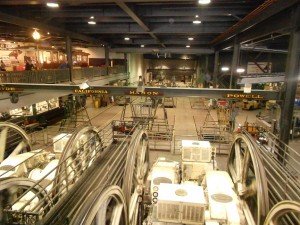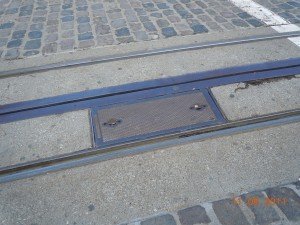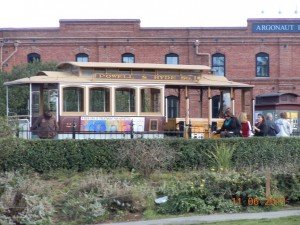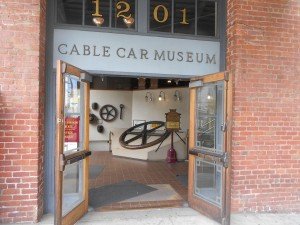
Thank you for reading this post, don't forget to subscribe!
Out of all the various means of public transportation, the cable car, most notably the San Francisco cable car, is the only vehicle that doesn’t have a readily apparent exterior means of power. Cable cars of San Francisco have no overhead wires, no exhaust fumes, no electric third rail. The cable car glides along it’s tracks effortlessly whether the terrain is flat or highly steep.
One of the remarkable things about cable car technology is that it is relatively simple. By the same token, a cable car system such as the cable cars of San Francisco was very expensive to build. Aside from laying cable tracks, the task of building a cable car system, requires a massive Power Plant which contains large engines and wheel mechanisms. Quite different and more expensive than hanging electric streetcar wires.
Andrew S. Hallidie and the Early Cable Cars
It just so happened that the father of cable cars of San Francisco’s was a man named Andrew S. Hallidie. Hallidie was quite knowledgeable about wire. His father held several patents in Great Britain involving wire cable or sometimes referred to as wire rope. Andrew Hallidie had wire cable patents himself in the U.S. Hallidie was the first person to make wire rope in California having used wire rope cable to pull ore cars during the California Gold Rush.

During the early days of the San Francisco Cable Cars there were cable tracks all over the city. Each one was run by a separate railway company. Over time there were mergers and acquisitions. After the 1906 San Francisco Earthquake and Fire things changed immensely. The electric streetcar was on the scene and the devastating earthquake gave many companies a reason to abandon certain routes. The earthquake signaled the time of everlasting change to San Francisco’s cable car lines.
You’ll find the following two articles on our Western Trips site of interest. A Visit to the San Francisco Cable Car Museum and The Electric Railroads.
The Power House
A good argument could be made that the most important part of the street cable car system is it’s Power House. It is from the power house that the wire cable itself enters and leaves. It’s the Power House that feeds the entire cable system. In the beginning, every separate cable car line had it’s own dedicated Power House and their own cable tracks. Some systems actually had more than one Power House. During the heyday of the cable cars, San Francisco had no less than nine different Power Houses and Car Barns.

Inside the Power House are very large winding wheels and engines. The wheels are referred to as “sheaves“. The wheels turn with the power of the engines and feed the cable out of the building and under the street surface. When this technology was first developed, the engines were powered by steam and as a result burned quite a lot of coal every day to heat the steam boilers.
The wire cable is wound around the sheaves or wheels in a figure eight. In addition to this, additional sheaves that are known as a “tension carriage” is employed so that the lines stay taut at all times. The tension carriage can adjust tension as required. This will vary by the number of cars on the line as well as the passenger load.
The Street

Chances are, when you’ve taken a ride on a San Francisco cable car, you’ve noticed the slot between the two rails that the car travels on. It is in this slot, slightly under the street surface, that the cable wire runs. You most likely will hear it’s whirring sound. It is the one and only power source for a cable car. You might find it interesting to note just how much cable car wire is used today in San Francisco. According to the San Francisco Cable Car Museum, the grand total of cable used in all three of today’s cable car lines is 56,750 feet. The cable itself is a very strong bundle of metal wires. Today’s cable car cables run at a constant 9.5 MPH.
The Cable Car
While the Power House provides a constantly moving cable wire, it’s the cable car operator who decides how and when to use the cable. The cable car operator uses what is called a “grip” to engage the moving cable. It’s an appropriate name in as much as what the “grip” does is grip the cable. When the operator pulls back on the “jaw“, the mechanism grabs the moving cable. When the grip is completely engaged on the cable, the cable car will move at 9.5 MPH, the constant speed of the moving cable. The cable car operator can also reduce speed by letting up a bit on the grip. When the grip is unengaged from the cable, the car will stop.

In addition to the grip mechanism, a cable car has brakes. Today, there are three types of brakes on a San Francisco cable car. One is a foot pedal brake. The foot brake operates the brake shoes located on both the car’s front and back wheels. Another is a track brake that essentially sticks wood into the cable slot below. Yet another is the emergency brake which is referred to as a “guillotine brake“. This emergency braking mechanism consists of a piece of steel about one and one-half feet long that hangs under the cable car. If it is deployed, the piece of steel wedges tightly into the cable slot on the street. It wedges so tightly that sometimes a torch is needed to get it out.
The very fact that the grip can fully engage the cable and hold on tightly is why cable cars can go up very steep inclines and do it in wet weather. As you can appreciate, the advent of the San Francisco cable car was a welcomed event.

The early cable car could go up and down a steep hill where horse carts would sometimes get out of control and cause accidents sometimes leading to the death of the animals. It was this very problem that led Andrew Hallidie to devise the cable car concept.
San Francisco was by no means the only city employing cable cars. Cable cars at one time operated in Sydney and Melbourne Australia, Bogota Colombia, Lisbon Portugal, London England and several more cities.
If you travel to San Francisco California, you do want to add the faThe Cable Car fascinating Cable Car Museum to your trip itinerary. The Cable Car Museum is located at the corner of Mason and Washington just a few blocks north of Nob Hill. The museum is free to visit and showcases some excellent historic exhibits of both the cable cars and old time San Francisco.
Two excellent books on San Francisco’s cable cars are The Cable Car Book by author Charles A. Smallwood and San Francisco’s California Street Cable Cars by authors Walter Rice, Emiliano Echeverria and Michael Dolgushkin.
(Photos from author’s private collection)
